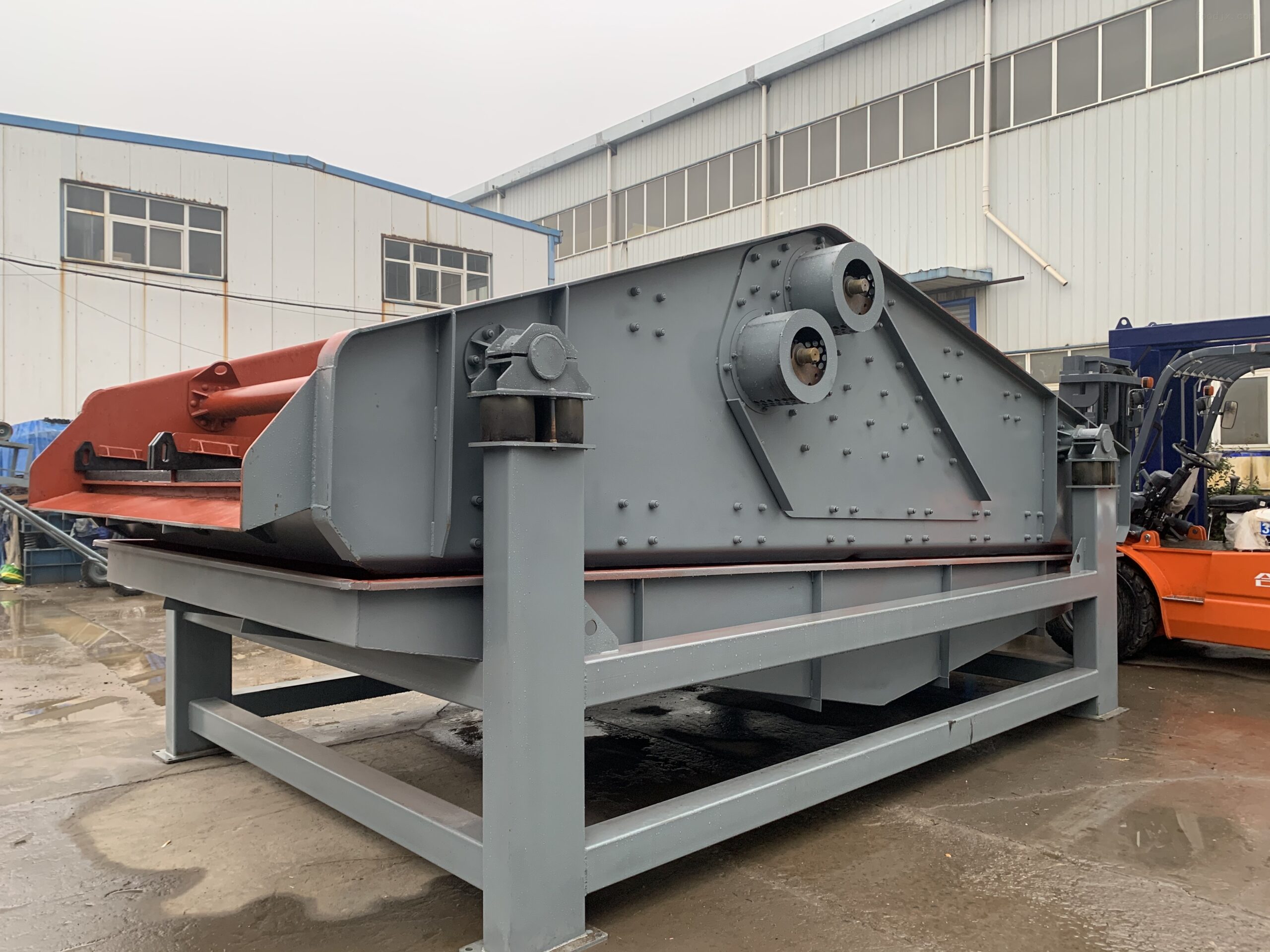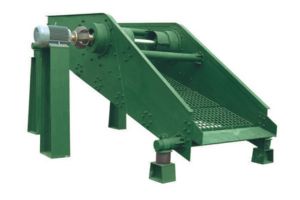What is circular motion vibrating screen?
Circular motion vibrating screen is a kind of vibrating screening equipment.
Its working principle is to use the centrifugal force generated by the eccentric device to make the screen box vibrate along an approximate circular trajectory.
In terms of structure, it usually includes screen box, screen mesh, excitation device, support device and other parts.
This kind of vibrating screen is characterised by a circular vibration trajectory and relatively large amplitude, which can achieve efficient screening and classification of materials.
In modern industrial production, circular motion vibrating screen, as an important screening equipment, is widely used in various fields. With its unique working principle and excellent performance characteristics, it provides an efficient and reliable solution for screening and classification of materials.
Circular motion vibrating screen, as the name suggests, has a circular motion trajectory of the screen box. This movement is realised by an eccentric shaft exciter or other similar devices. The eccentric shaft generates centrifugal force when rotating, so that the screen box produces circular vibration with a certain amplitude.
Advantages of circular motion vibrating screen
This type of vibrating screen has many significant advantages. Firstly, it has a large capacity and can handle a large amount of material per unit time. At the same time, the screening efficiency is also very high, and it can effectively separate materials of different particle sizes. With its long screening line length and various screening specifications, it can meet various different screening needs.
Considerations for the design and use of circular motion vibrating screens
The width and length of the screen surface is one of the important parameters. Generally speaking, the width of a linear vibrating screen screen determines its processing capacity, and the larger the width, the higher the processing capacity usually is. The length of the screen, on the other hand, correlates with the screening efficiency, with longer screens providing higher screening efficiency. However, increasing width is often limited by the structural strength of the screen frame, and too much width may result in shorter frame life. In practical application, it is necessary to consider the specific situation comprehensively, and after determining the screen width, the screen length is determined based on a certain ratio. For example, the aspect ratio of mining vibrating screen is usually more than 2, while the width ratio of coal vibrating screen is about 2.5.
The angle of the screen also has an important influence on the screening effect. The inclination angle of the screen surface is not only related to the sieve particle size, but also closely related to the screening efficiency. Although the larger angle of inclination is conducive to the discharge of materials, but the material in the sieve surface will shorten the residence time, reducing the opportunity of particle penetration, thus reducing the screening efficiency.
The size, shape and opening rate of sieve holes should not be ignored. Larger sieve holes can increase the processing capacity per unit sieve area, which in turn improves the screening efficiency. The selection of the sieve size depends mainly on the purpose and requirements of screening. For conventional screening of larger sizes, the size of the sieve hole is generally equal to the size of the sieve; when a smaller size is required, the size of the sieve hole should be slightly larger than the size of the sieve, in order to carry out approximate screening. Different shapes of sieve holes also have their own characteristics, round and square sieve holes in the lower part of the sieve shape is more regular, while the rectangular sieve holes are more likely to make the flake and strip particles leak out, so in some cases, rectangular sieve holes may need to be designed a little smaller.

Application of circular motion vibrating screen
In the mining industry, it can be used for screening and grading of ores; in the field of building materials, it can screen materials such as sand and gravel; it can also be seen in the industries of transport, energy and chemical industry. For example, in the sand production line, the material processed by the crushing equipment is screened by the circular motion vibrating screen, which can produce sand with more uniform particle size and better quality, which not only meets the high-quality requirements for sand in construction, but also brings considerable economic benefits to the users.
Common problems and solutions of circular motion vibrating screen
Broken screen
Problem causes:
1.the material is mixed with sharp, hard foreign matter, which scratches the screen mesh in the screening process.
2.screen mesh material quality is poor, not strong enough. 3.
3.the tension of the screen mesh is not strong enough, resulting in shaking and excessive stretching of the screen mesh in the vibration process.
Solution:
1.set up a debris removal device before feeding to remove the sharp foreign objects in the material.
2.Select high-quality, high-strength screen materials.
3.check and adjust the tension of the screen mesh regularly to ensure that it is in proper condition.
Low screening efficiency
Problem causes:
1.the screen holes are blocked, and the materials can not pass through the screen holes smoothly.
2.uneven feeding, resulting in part of the screen surface is overloaded, while other parts are not fully utilised.
3.the amplitude is too small, the material moves slowly on the screen surface, affecting the screening effect.
Solution:
1.clean the screen holes regularly to prevent clogging.
2.optimise the feeding method, use uniform feeding equipment.
3.adjust the eccentricity of the eccentric shaft eccentric distance or excitation force, increase the amplitude.
Abnormal vibration
Problem causes:
1.shaker failure, such as damaged parts, poor lubrication.
2.the spring is damaged or the stiffness is inconsistent, affecting the balance of the screen box.
3.the support device of the screen box is unbalanced or loose.
Solution:
1.check the shaker, replace damaged parts in time, and ensure good lubrication.
2.Replace damaged springs to ensure consistent spring stiffness.
3.Check and adjust the support device to make it balanced and stable.
Excessive noise
Problem causes:
1.serious wear and tear of the bearings, resulting in large friction and vibration noise.
2.the fastening bolts are loose, resulting in collision between the parts to produce noise.
3.The connection between the shaker and other parts is not tight.
Solution:
1.Replace worn bearings.
2.Tighten loose bolts.
3.Check and make sure that the shaker is tightly connected to other parts.
Material deviation
Problem causes:
1.the thickness of the material on both sides of the screen surface is not consistent.
2.The installation of the screen box is not flat.
Solution:
1.adjust the feed opening so that the material is evenly distributed on the screen surface.
2.Reinstall the screen box to make sure it is level.
The output is not up to expectations
Problem Cause:
1.Insufficient motor power to provide enough power.
2.improper selection of screen mesh, too fine screen mesh limits the output.
Solution:
1.replace the motor with higher power.
2.according to the actual demand, choose the right mesh screen.
However, some problems may be encountered when using circular motion vibrating screens. For example, uneven screen surface may lead to uneven distribution of materials, overloading on one side and almost empty on the other side, thus increasing the wear of the screen surface; the irrational design of the feeding funnel or the distance from the vibrating screen may cause excessive impact at the feeding point, resulting in problems such as beam rupture or case cracking. In order to solve these problems, attention needs to be paid in the installation, commissioning and daily maintenance of the equipment. Choose the appropriate feeding method and funnel structure to ensure that the material can be evenly distributed on the screen surface; regularly check and maintain the equipment, and find and repair any possible damage in time.

How to ensure the screening efficiency of circular vibrating screen?
Reasonable selection of screen mesh
According to the characteristics of the screening materials and particle size requirements, choose the appropriate aperture, material and weaving screen.
Ensure that the installation of the screen mesh is firm, and the tension is moderate, to avoid the screen mesh relaxation affecting the screening effect.
Optimised feeding
Adopt uniform and stable feeding method, feeder can be used to control the feeding speed and flow rate.
Ensure that the feed material is evenly distributed on the screen surface to avoid local accumulation or material bias to one side.
Adjustment of vibration parameters
According to the nature of the material and screening requirements, reasonable adjustment of vibration frequency, amplitude and vibration direction.
Usually, a larger amplitude and appropriate vibration frequency can help to improve the screening efficiency.
Regularly clean the screen
Remove the blockage and adhesion on the screen mesh in time to prevent the screen holes from being blocked.
Cleaning device or regular manual cleaning can be used.
Ensure that the equipment is in good operating condition
Regularly check and maintain the circular vibrating screen, including the motor, bearing, exciter and other parts.
Timely replacement of worn parts to ensure the normal operation of the equipment.
Control material humidity
For materials with large humidity, they can be pre-dried to reduce the humidity of the material.
Over-wet materials are easy to adhere to the screen mesh, reducing the screening efficiency.
Reasonable design of screen box structure
Optimise the size, shape and angle of the screen box, so that the material has enough residence time and movement track on the screen surface.
Operator training
Train the operators to make them familiar with the operation and maintenance points of the equipment.
Ensure that the operators can make correct adjustments and treatments according to the actual situation.
With the continuous progress of science and technology and the growing industrial demand, the circular motion vibrating screen is also constantly developing and improving. In the future, it may be further improved in screening accuracy, processing capacity, degree of automation, etc., to better adapt to a variety of complex screening tasks and production environments.
In short, with its efficient screening performance, reliable structure and wide applicability, the circular motion vibrating screen has become an indispensable and important equipment in many industrial fields. With proper design, use and maintenance, it will continue to play an important role in optimising the production process and improving product quality. Whether it is in the beneficiation operation of mines or in the production of building materials, the circular motion vibrating screen contributes to the development of various industries in its unique way.

